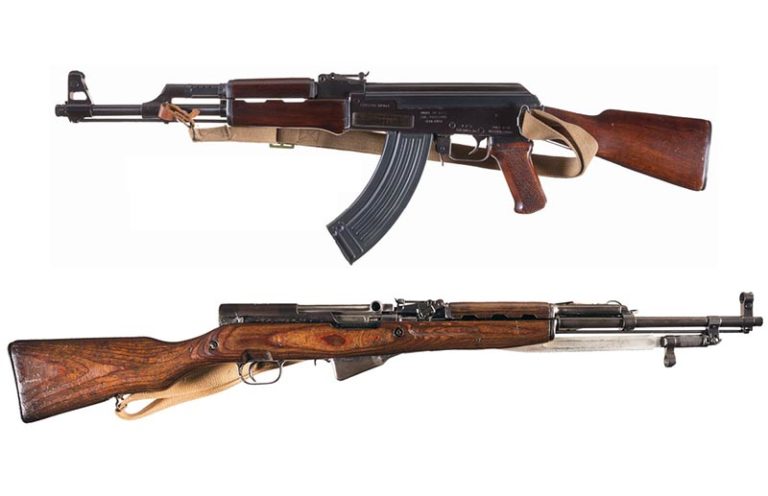
The SKS vs AK-47, if you could only have one, which would it be? We assess the pros and cons of these two iconic Soviet carbines.
Of all the firearms that have ever been fielded, the AK and SKS are two designs that have seen some of the most action. Since they were first developed in the wake of WWII, these iconic Soviet carbines have been used the world over, and they’re not through fighting yet.
If it’s been a while since you last checked in on the state of the Combloc surplus market, you may be shocked to discover just how radically it’s changed over the past couple of decades. While many can remember the days of $99 SKSs at their local hardware store, that era has unfortunately passed. The average price of both rifles has increased considerably, and those who are in the market for a 7.62x39mm gun may now be forced to choose one or the other. With many factors to consider besides cost, however, we’re going to dive into the SKS vs AK-47 debate to help you determine which is the better option if you could only own one.
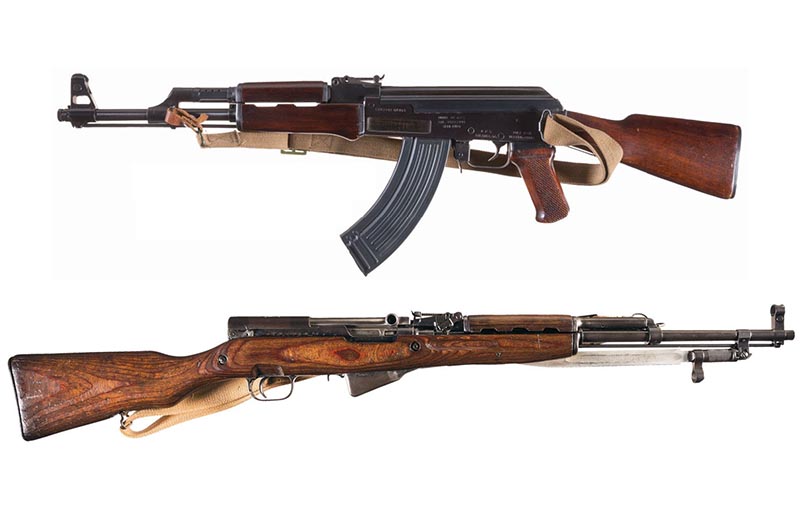
SKS vs AK-47 Development
From the moment the AK-47 was born, its qualities were being compared to those of the SKS. Ready to modernize their armed forces following WWII, the Soviet Union was dedicated to developing a new family of weapons to replace the bolt-action Mosin Nagants and crude submachine guns that comprised the bulk of their inventory. Settling on the M43 cartridge that would become 7.62x39mm early in its development, the USSR was planning on adopting four new weapons chambered for it: a submachine gun, a belt-fed machinegun, a semi-auto carbine and a bolt-action rifle for reservists. It was quickly decided that the bolt-action was redundant and subsequently abandoned, but development moved forward on the other three designs. Sergei Simonov’s SKS was formally adopted as the new carbine in 1945, and Mikhail Kalashnikov’s AK-47 filled the role of submachine gun when it was adopted in 1949.

There’s a good chance that if the original pattern of AK-47 had been more successful, the SKS would not have been produced in the numbers that it was, but as is true with most new firearm designs the Type 1 AK-47 had some kinks to work out. With the AK not being perfected until the development of the AKM in 1959, it left about a 10-year period where AK-47s were made with expensive milled receivers, defeating much of their original goal of being cheap to produce (it was originally intended to have a stamped receiver like the AKM, but Soviet manufacturing wasn’t up to snuff until ’59). When looking at the SKS vs AK-47, the Soviets determined that the AK could do just about everything the SKS could do in an infantry role, so the SKS was only produced in Russia as a stopgap measure until the fully realized AK could go online. Once that came true with the adoption of the AKM, SKS production dropped nearly to zero in the USSR.
During this interim period, the Soviets did issue the SKS to many troops, but as this was during peacetime, the rifles did not see much action in Russian hands. In Russia, it would go on to mostly be used for ceremonial and parade purposes, and it still fills that role today. Outside of Russia, however, Simonov’s carbine led a much more difficult life. The USSR shared the technical data package of the SKS early on with several allies, including China, Yugoslavia, Romania and the DDR. It was primarily China’s large-scale production of the SKS (which they called the Type 56, the same as their AK) which let the design see the amount of action that it did. Widely proliferated throughout Southeast Asia and Africa while the continents were experiencing frequent conflict, the SKS would prove to be a very effective weapon that was well-liked by most of its users. They’ve taken part in most major conflicts around the globe since their inception and they will continue to do so for the foreseeable future.
Just because the Red Army decided that they did not need the SKS once the AKM became viable to mass-produce, that doesn’t mean that the SKS still couldn’t be the better rifle for you.
SKS vs AK-47 Design Features
When comparing the design features of the SKS vs AK-47, it’s important to keep in mind the role that each was intended to fill. The SKS was envisioned as being the USSR’s next infantry service rifle that would replace the Mosin Nagant. Because of this, it was given a traditional rifle layout, a fixed internal magazine that was to be loaded by stripper clip and a barrel length of about 20-inches (the same as the Mosin Nagant M38 and M44 carbines). By keeping these new gas-operated weapons as semi-auto only, soldiers were clearly intended to utilize good marksmanship. Besides some later Chinese variants, SKSs feature wood stocks, milled receivers and folding bayonets, again clearly taking design cues from the Mosin carbines that had been widely issued up until the SKS’ adoption at the end of the war.
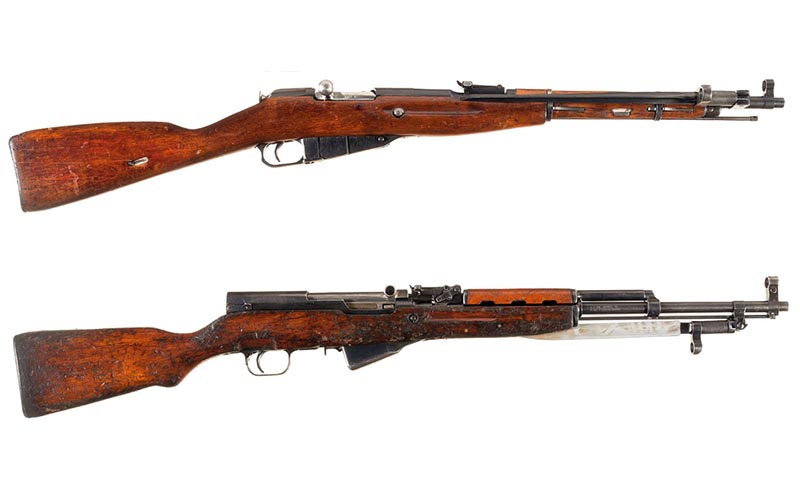
The AK-47, and by extension the now-prolific AKM, was designed to fill a different role. Originally issued with both fixed wood and underfolding metal buttstocks, the AK-47 was a select-fire weapon from the get-go. While Stalin himself supposedly requested that the SKS feature a fixed-magazine (10 rounds) to save money and simplify logistics, Kalashnikov’s design was always intended to use detachable 30-round mags similar to the submachineguns in service that it was intended to replace.
It also was given a shorter barrel of about 16-inches. While some may expect that the longer barrel of the SKS will impart greater accuracy, in reality, the differences in mechanical accuracy between the two designs are negligible. While most shooters can achieve slightly better accuracy with an SKS than with an AK, this is mostly due to the longer sight radius and ergonomics of the Simonov. Furthermore, 7.62x39mm achieves near maximum velocity out of a 16-inch barrel, only gaining an average muzzle velocity of about 60 FPS more from a 20-inch barrel.
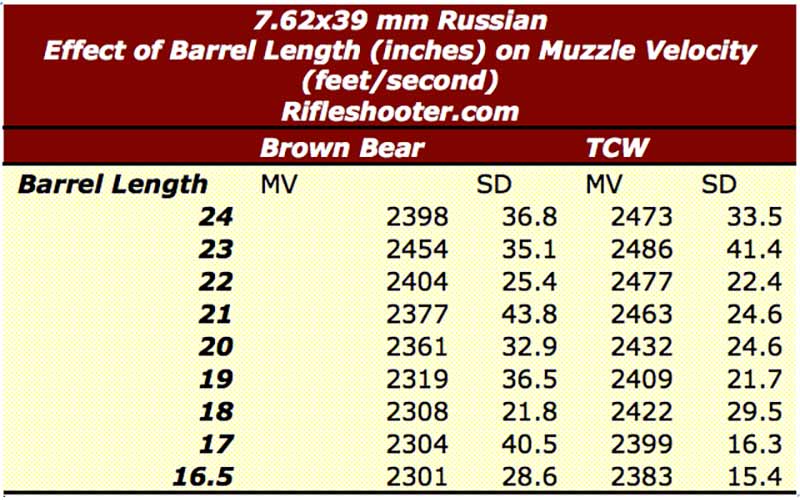
Another notable design difference includes the fact that AKs use long-stroke gas pistons while the SKS uses short-stroke. While the SKS is still considered to be very reliable, it’s not on the same level as the AK mostly because of this difference. SKSs also feature a last-round bolt-hold-open device while AKs do not.

SKS vs AK-47 Prices
While the goal of this article is to compare the physical qualities of the SKS vs AK-47, this discussion can’t be had without some mention of respective prices. Choosing an SKS over an AK made more sense when the former could be acquired for less than $200, but that is no longer the case. The cheapest SKS you will likely be able to find for sale in 2022 will be at least $400, and it will probably be a very poor condition Chinese model. Assuming that it’s mechanically sound and is only in need of some refinishing, this is still about $400 less than what the most basic, yet decent, AK will cost. The Romanian WASR fits that description and can currently be found for a bit over $800 typically.
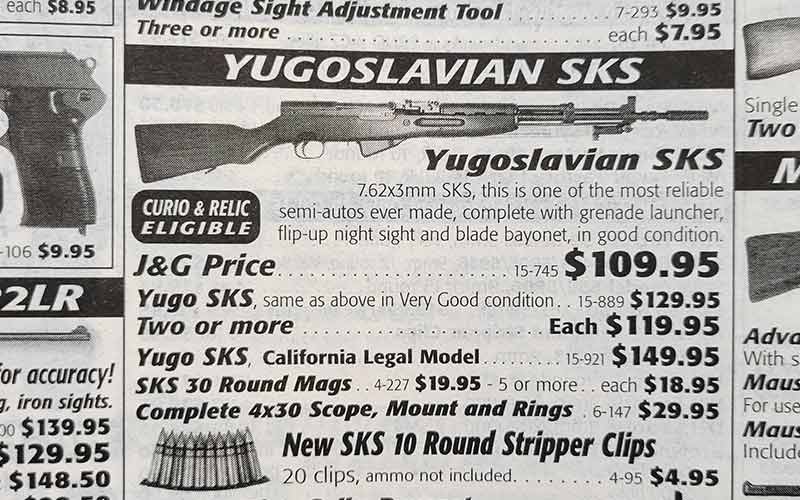
While it’s great that SKSs were once sold for so little, it has skewed the American perception of their quality. These are milled receiver rifles built in the old-school way, reminiscent of firearms used during WWII. The truth is that they were always worth more than what they were being sold for, but international political circumstances led them to be surplussed for pennies on the dollar. Americans who were old enough to be there got to reap the rewards, but these rifles’ prices are now starting to reflect their build quality more accurately.
It would be wonderful if these were still available for $99, but if you decide that you really want an SKS you shouldn’t feel bad about paying a bit more for one as long as it’s in decent mechanical shape. Another point on the price of each is that when one buys an AK, especially a new production WASR, it is accepted that the furniture they come with will need to be replaced with something better. Most will also want to buy at least a few spare magazines. Unless modified by a previous owner, most SKSs will include their original-issue wood stocks, folding bayonets and fixed magazines, meaning that the rifle is already a complete package save for maybe some stripper clips and a sling.
If You Could Only Have One
Depending on the reasons you have for wanting a 7.62x39mm rifle, the cost may or may not be relevant. Are you on a tight budget? Are you in the market purely for collecting or historical purposes? If either is true for you, the SKS is the clear winner due to still being both cheaper and more authentic than the commercial AK variants available in the States. If you plan on using the gun for practical purposes, however, there are other factors worth considering.
If you want either one of these rifles for practical purposes, your desired application should be well thought out. Are you looking for a varmint rifle to tote around your ranch? A truck gun? Or maybe you just want something for putting holes in paper with at the range.
If you are looking for a handy or compact rifle, the SKS is worse by most metrics, but not by much.
When comparing the unloaded weights of a standard SKS with an early, milled AK-47 (with steel magazine inserted), they are nearly identical. When compared to the more common stamped-receiver AKM, however, the SKS is about a pound heavier. The SKS has a longer barrel and a fixed stock too. AKs are available from the factory with folding stocks in some cases, and short pistol variants have become readily available as well. While AKs use 30-round mags as standard, they can also use magazines as small as five rounds to reduce the package’s bulk. If you want your 7.62×39 gun to be as compact as possible, the AK has greater potential for it. That being said, the SKS is also very sleek and handy due to its fixed internal magazine and lack of a pistol grip. Ultimately, the winner here depends on exactly where you plan on storing it.
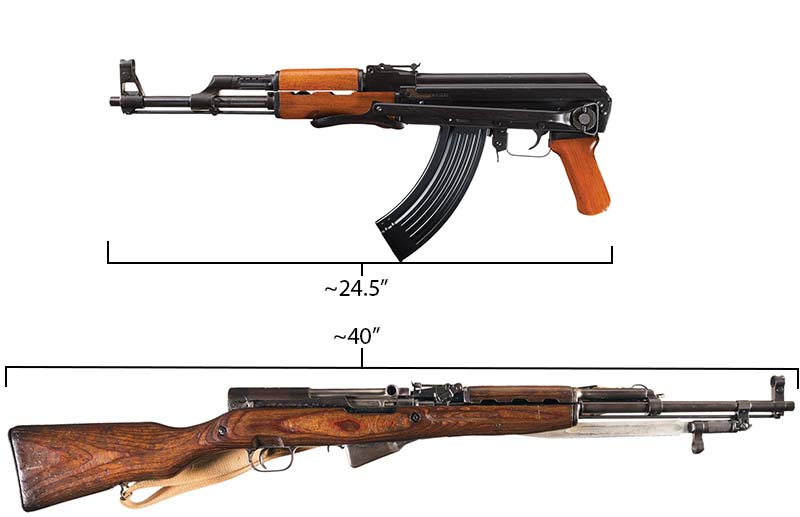
Personal preference also plays a role in determining which would be better for you. If you’re more used to the handling of traditional rifle platforms or want your gun to be less intimidating to folks who may view an AK as “the bad guy gun”, the SKS is the clear winner. The only thing on a wood-stocked SKS that screams “military rifle” is its bayonet, and it can be removed if one so desires. Another consideration is that if having a high ammo capacity isn’t a concern of yours, the SKS has an edge in simplicity and reliability. Faulty detachable magazines can cause issues for any gun, and AKs are no different. Plus, if your only magazine is lost or damaged, you’re left with what is functionally a single-shot rifle. As long as one has loose ammunition to feed their SKS, however, it can continue to operate as intended.
Local laws may play a role in your decision as well, as there are unfortunately many jurisdictions in the United States that have either banned the AK family of weapons by name or have severely restricted their form by banning certain features. If the only AK that you can legally own will have a neutered pistol grip and a 10-round magazine, you might as well just get an SKS instead. The AK has a much greater aftermarket for adding optics and other accessories of course, but customizing each gun is a conversation for another day.
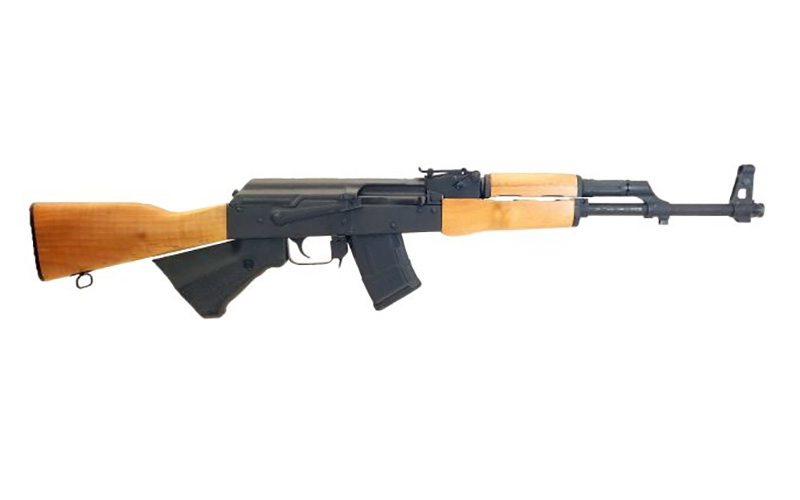
Final Thoughts
In short, when looking at the SKS vs AK-47, the SKS still may be the better choice for you. Despite being more expensive now than they were previously, they can still be found for much cheaper than a good AK, and the SKS has greater potential for collectability as well. Those who live in areas with legal restrictions on AKs or their features have good reason to consider the SKS, too.

For essentially any role that is not defense or combat-oriented, the SKS can at least perform on par with the AK, if not better in some areas. If the gun you want may ever be forced into a tactical application, however, the AK still has more potential to be the better modern fighting rifle. Ultimately the choice is yours and there are far too many factors at play to definitively claim that one is a better purchase than the other, but if you understand exactly what you want the gun to do for you, that choice should be an easier one to make.
More On The SKS & AK
- The Best Imported AK Rifles You Can Find In The U.S.
- Market Trends: Surging Prices Of The SKS And Other Milsurp
- 7.62 AK Mags: What You Need To Know
- Pushing SKS Upgrades To Their Limit

Next Step: Get your FREE Printable Target Pack
Enhance your shooting precision with our 62 MOA Targets, perfect for rifles and handguns. Crafted in collaboration with Storm Tactical for accuracy and versatility.
Subscribe to the Gun Digest email newsletter and get your downloadable target pack sent straight to your inbox. Stay updated with the latest firearms info in the industry.

![Best Concealed Carry Guns In 2025 [Field Tested] Wilson Combat EDC X9S 1](https://gundigest.com/wp-content/uploads/Wilson-Combat-EDC-X9S-1-324x160.jpg)


![Best 9mm Carbine: Affordable PCCs [Tested] Ruger Carbine Shooting](https://gundigest.com/wp-content/uploads/Ruger-Carbine-Shooting-100x70.jpg)
![Best AR-15: Top Options Available Today [Field Tested] Harrington and Richardson PSA XM177E2 feature](https://gundigest.com/wp-content/uploads/Harrington-and-Richardson-PSA-XM177E2-feature-100x70.jpg)

The playing field can be evened up between the SKS and the Ak47, when you add the detachable magazine to the SKS. THe conversion is easy and takes less than a minute.
ALl you do, is remove the internal magazine assembly, which can be done during a regular field strip, and then re-assemble the SKS rifle. The Modern 30 round SKS magazines snap right in and are retained by a spring loaded lever at the bottom of the rifle.
The SKS is easier to field strip and clean, I believe.
lastly, in civilian form, both are semi-automatic only. So, The only difference is in portability and handling. The AK47 is slightly lighter, and easier to maneuver in tight quarters. The SKS is more of a frontier type battle rifle. I’ve modified mine over the years, and added a Fiberglass stock, a small 4x power illuminated reticle scope, and cleaned the bore with some copper solvent. It’s accuracy is exceptional, when using American made ammunition, and a good copper fouling cleaner.
This post details so much more information than similar blogs, and it’s immensly useful to me. Will be returning to see more writing from you! mind if I share this?
I was fortunate enough to buy an SKS (China: Norinco) back in the early 1990s for $85. Thanks for the
article on both the SKS and AK rifles. I appreciate reading and “boning-up” on what I have.